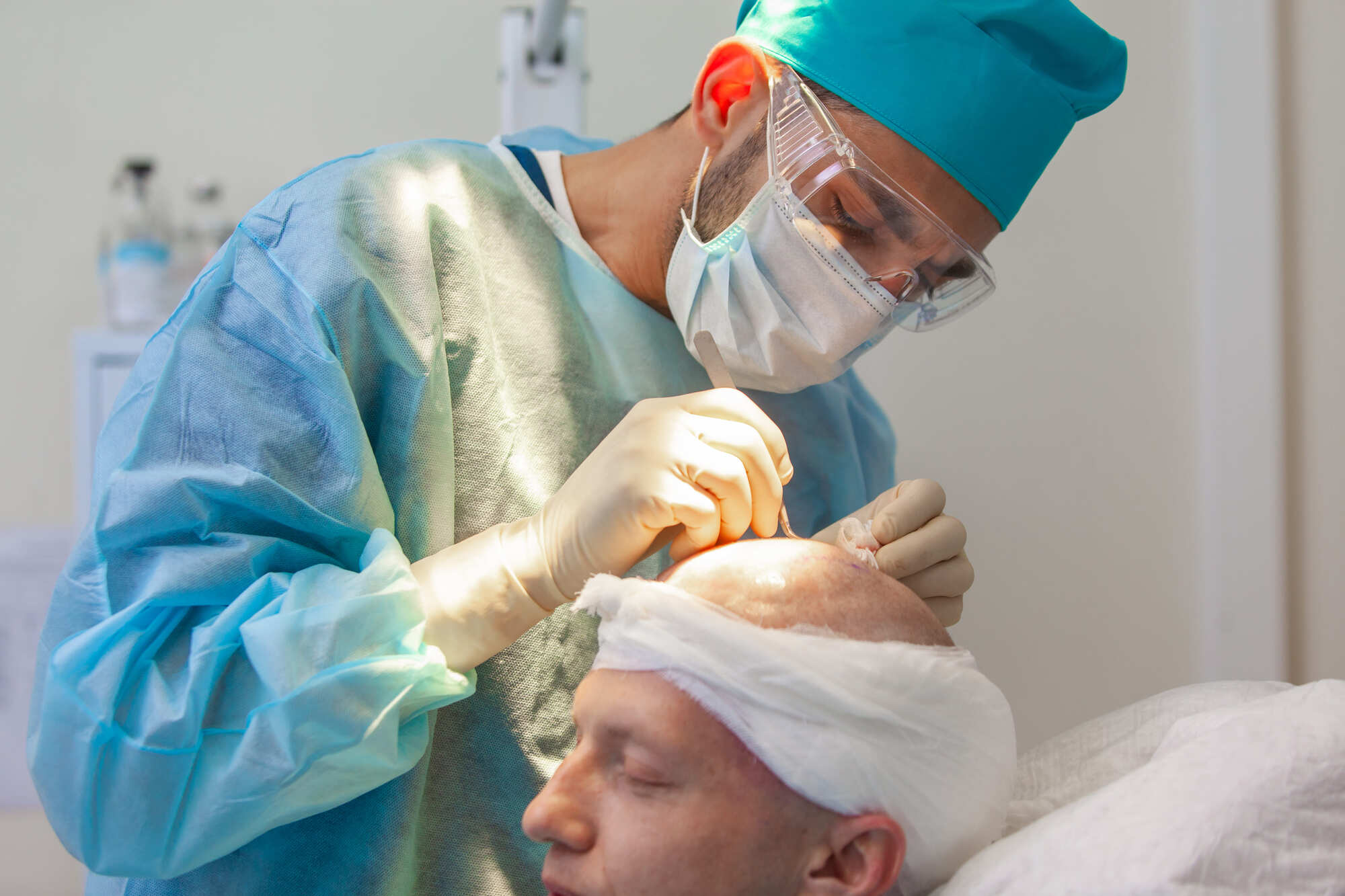Hair Transplant

What is hair transplantation?
Hair transplantation is a natural and permanent solution for the problems of thinning and baldness in people who have hair loss problems or who have lost their hair. Hair transplantation is the process of transplanting healthy and living hair follicles with microsurgical methods to areas where hair follicles are no longer alive and balding occurs. Hair transplant operation is planned and applied individually. In the hair transplantation operation, hair follicles resistant to hair loss in the nape of the patient’s neck are taken with certain gaps and transplanted to the sparse or completely lost parts according to the personalized planning. The aim is to provide a natural, permanent, healthy, hair appearance that is suitable for the facial features of the person by providing a naturalness that will not be obvious that the transplantation has been performed in the hair area.
When is hair transplantation performed?
Hair transplantation treatment is applied after irreversible hair loss. In the case of hormonal hair loss, our doctors usually recommend non-surgical medical treatment. With the treatments we apply, we monitor hair regrowth more intensively in women. In men, with our non-surgical treatments, our aim is only to stop or slow down hair loss and to offer a solution against the loss of existing hair. The majority of our patients do not want to use medication or treatment protocols that will be applied for a long time or for life. When it is determined by our specialists that drug treatment is not possible or that the desired result cannot be achieved, planning for a hair transplant operation is carried out. There is no age range restriction when it comes to individuals of legal age for hair transplant operation. Hair transplant procedures are applied after the doctor’s examination. We are proud and excited to provide a full range of hair transplantation services under the most hygienic and sterile conditions with our experienced medical team who are experts in their field and have worked in many countries.

Who can have a hair transplant?
Hair transplantation can be performed on any healthy person of legal age. The most important determining factor for the operation is that your hair in the donor area, which is the back of the head and the upper part of the nape of the neck, which has the feature of not falling out, is in sufficient quantity, frequency and health.
Hair transplantation can be performed on any healthy person of legal age. The most important determining factor for the operation is that your hair in the donor area, which is the back of the head and the upper part of the nape of the neck, which has the feature of not falling out, is in sufficient quantity, frequency and health.
For patients with chronic diseases and patients who need to take medication continuously, detailed information (procedure time, anesthesia, medications to be used, all operational details) is given to the doctor who follows our patient and an ‘approval report’ is requested from the doctor who follows the patient in writing that there is no harm in performing the procedure.
Diabetes and hypertension are not obstacles for hair transplantation. In patients with regular blood sugar control and hypertension patients whose blood pressure can be kept at normal levels with medications; our operation is performed safely with strict and careful monitoring and control.
DHair transplantation is not recommended for patients who “must take blood thinners for life”. Because discontinuation of these blood thinners poses a life risk.
Hair transplantation can be safely applied in hair loss due to the following reasons:
- Male pattern hair loss (androgenetic alopecia)
- Female pattern hair loss
- Congenital regional hair loss
- Hair loss due to burns
- Accident and surgery scars (such as head injury, facelift operation)
- Localized hair loss caused by a previous infection
- Hair loss caused by combing the hair back tautly or making a bun (Traction alopecia)
There is no specific age limit for hair transplantation. For hair transplantation; there is no need to wait for the completion of hair loss. Because the completion of the hair loss process is usually between the ages of 35-40. Even after the age of 40, a small amount of hair loss and thinning can be seen. Hair transplantation between the ages of 20 and 40, when the person cares most about his/her appearance, provides positive psychological benefits. However, hair transplantation can also be performed on 70-year-old people who meet the necessary operational conditions.
People who are considering hair transplantation must be examined and planned by doctors specialized in hair transplantation.
During the examination, the structure of the existing hair in the area to be transplanted and the structure and density of the hair in the donor area are examined, and as a result, it is calculated how much hair follicle transplantation the person needs and how many grafts can be taken from the nape area. Operation planning is made accordingly.
During the general examination, it is checked whether the person has a previous or ongoing illness or health problem. It is checked whether there is an obstacle to hair transplantation or a condition that threatens general health.
The person’s hair structure, hair color, hair strand thickness, frequency in the donor area, the degree of hair loss, whether the hair is curly or straight, and even the color of the scalp are important.
All these analyzes are the most important issues affecting the success of hair transplantation. Examination, planning and transplantation planning should be done by taking these factors into consideration.
The hairline is a personalized anatomical line. It is determined according to the natural hair border from the area where the forehead tissue ends and the hair tissue begins. The most important point in hair transplantation is to pay attention to the forehead muscle. The hairline can be adjusted as desired without going down to the forehead muscle and without damaging the mimic muscles. In people with a wide forehead or very empty hair on both sides, the hairline can be changed without touching the forehead line. The desired shape can be made according to the patient’s face type, hairstyle, previous hair loss pattern and the condition of the forehead muscle and balding skin.
In order for the transplanted hair to look natural, the operation must be performed by specialized doctors and experts. In hair transplantation operations performed by experienced specialists, naturalness can be achieved at a level that will not be obvious that transplantation has been performed. We aim for maximum hair density with the FUE, Sapphire FUE and DHI techniques we apply in hair transplantation.
Shock hair loss after hair transplantation is a temporary condition experienced by some people after hair transplantation.
The transplanted hair may exhibit a rapid loss in the short period following the hair transplantation. Although this loss may cause doubt and anxiety about the success of the hair transplantation process, shock loss is a normal and healthy process.
After this temporary loss, the hair continues to grow back in a strong and healthy way.
Shock hair loss after hair transplantation is a natural and healthy process that confirms the beginning of new hair growth and precedes the growth of permanent hair.
There are multiple factors that can trigger shock hair loss after hair transplantation.
The two main factors that cause shock loss, which is a temporary and healthy process, can be listed as follows:
After the hair follicles transplanted in hair transplantation settle in a new body, they enter a kind of acclimatization process. Since this acclimatization process cannot be completed immediately after hair transplantation, hair follicles may react by shedding their old hair.
Hair transplantation may cause minor trauma to the scalp. In this case, the hair enters the so-called resting phase and tends to fall out. It can be said that this is a preparation process for the growth of healthy and strong hair.
Shock hair loss after hair transplantation may result in the temporary loss of almost all of the hair.
After this phase, which should not be a cause for concern, the scalp continues to heal.
After this process, which is expected to be completed between the first month and the end of the third month, symptoms such as itching and acne may be observed, but the hair begins to grow again.
These symptoms are not negative, on the contrary, they indicate that the healing of the scalp is progressing as expected.
Techniques used in hair transplantation treatment in women; FUE hair transplantation and DHI hair transplantation methods. Micromotor is used in the FUE hair transplantation method. It does not leave a scar in the area where the hair follicles are taken. DHI method is a hair transplantation method that can be applied without the need to shave the hair. Both methods can be applied to women for hair transplantation treatment.
Revital Hair Clinic © 2024











